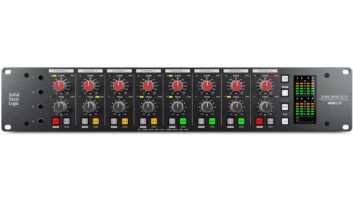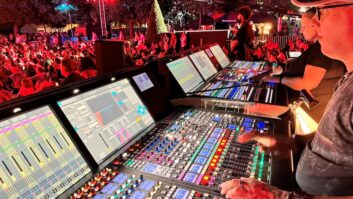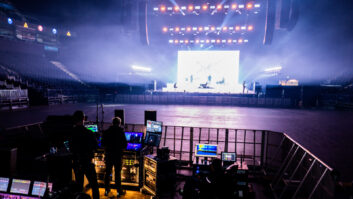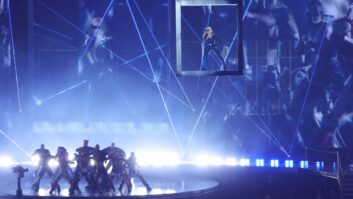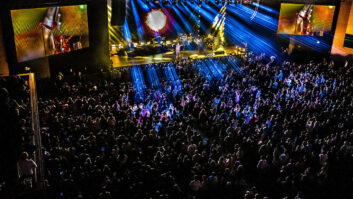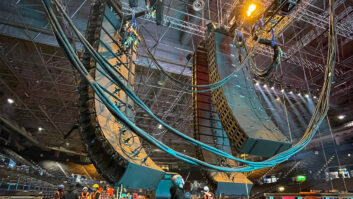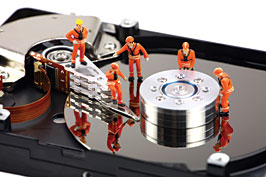
Photo: Amy Walters/Shutterstock
Between my wife, my kids and myself, there are 10 computers in our house — three Macs, six desktop PCs and a lapdog. My wife, Polly, and I both work from home, so that explains why we need so many — one for her, the rest for me and the boys. Despite having dedicated audio and video workstations, my desktop PC sees the most use — and abuse. It’s where the daily business gets done. While far from optimum for audio and graphic editing, it conveniently does more than its share of both. With two internal and at least one external drive, it’s also where my Website, articles, schematics, data sheets, fave music and class materials are stored. So when that computer isn’t happy, I’m not happy.
ON THE ROAD TO GREEN
One of my good or bad traits — depending on your perspective — is that I hate to throw things away. A perfectly functional computer can be “recycled” to perform a lesser task — the kids’ G3 iMacs and my dedicated Pentium 2 scanner being prime examples — because it is still quite usable (though this is a bad idea if you interpret Feng Shui strictly as uncluttered interior design).
The good news is that everyone is becoming more “green” conscious. This past fall, a locally sponsored electronic recycling event at the Mall of America parking lot yielded so many “contributors” that it overwhelmed and shut down the system. That so many people were saving their old junk and waiting for a free and convenient recycling opportunity sent a message that was heard from the big box stores and waste-management services all the way to government agencies.
WIDE SCREEN
For all the different jobs I do, dual monitors are essential. And while a dual monitor card should minimize potential conflicts, it was actually at the root of a problem that plagued my office PC several years ago. Nothing makes us feel more helpless than the blue screen of death, which happened every few months for about a year. Through this experience, I figured out a recovery trick that’s as simple as connecting the boot drive to another computer. Windows immediately recognized and fixed the “security descriptor” problems, after which the drive was as good as new. I did nothing but introduce one piece of hardware to the other. Next time a blue screen makes your day, try it; there’s nothing to lose.
It wasn’t until migrating to another motherboard that I accidentally stumbled upon the true cause of the problem: The OS install was done with a single monitor card. Everything seemed fine until the dual monitor card was installed — a more obvious conflict than before — but at least it happened right away.
Last summer, the analog monitor died on my scanning PC after 13 years of service. My office PC gladly gave up one of its own “tubes” in trade for a solid-state LCD upgrade, a stunning LG L226 22-inch, wide-screen display that was quite a bump up in terms of resolution and brightness. With its 3,000:1 contrast ratio, 2ms response time and 1,680×1,050 resolution, I was amazed at how small things could be made and still retain clarity — not a strong suit for analog but a piece of cake for the L226. The transition to an LCD screen took some getting used to; I’ll explore more about monitor technology next month.
DOS BOOT
Trying to bring your computer back to life? A common PC fix is turning off all resident programs that invade the Notification Area of the taskbar. This also applies to Pro Tools, which is particularly intolerant of background programs, especially anti-virus software.
When my current PC became sluggish, I immediately went on a search-and-destroy mission for viruses and adware to no avail. For a while, I even considered whether the new monitor’s significantly higher resolution was taxing the system. Whenever a computer is unhappy, my first inclination is to pull the boot drive and start fresh. I’m no fan of trying to fix a boot drive while it’s online and I don’t know many people who can. A fresh install on a new drive can solve a lot of problems. In this case, the computer was too new and I wasn’t ready to rebuild the desktop from scratch as there were just too many programs to load.
UNCONVENTIONAL
I’ve been using low-capacity boot drives for the operating system and related files. Rather than let new programs install themselves into the Program Files folder, I keep a similarly named folder on a separate drive. I also prefer to create storage folders that are logical to me rather than use the “nested” approach of storing files within a program’s folder. It’s a no-brainer for people who work with audio and video to keep their files on a separate, portable drive; backing up is easier when you know where everything is.
If my program drive gets weird, then everything can be dragged and dropped to a new drive without angering the OS goddess. (Remember to identically name the new drive.) Despite my best efforts, iTunes managed to load itself and all of my music files on the boot drive until it eventually had so little reserve that defragging didn’t help. This may have accelerated the problem.
BOOT COPY
Cloning a boot drive is not drag-and-drop simple. After some frustration with a well-known boot drive-copying utility, I took advantage of a 30-day trial version of Future Systems’ Casper (www.fssdev.com). It was so quick, easy and effective that I gladly gave them $50 for the license after the first day. The old drive was indeed the problem; my desktop and sanity (what’s left of it) were preserved. Casper also reports on the drive’s condition and suitability, as do other programs mentioned below.
LISTEN TO THE DRIVE
One of the clues to my boot drive problem was a cyclical mechanical noise that occurred about every five seconds. My friend Dave Meyers suggested the problem might have been due to thermal recalibration issues. This is not a concern with modern drives, but it was back in the last century when this 8GB Seagate drive was made (in ’99). If my experience serves one particular purpose, then it’s that listening closely can assist in the troubleshooting process — a “country geek doctor” diagnostic tool, especially if your noisy computers are kept behind closed doors.
REMOTE DIAGNOSIS
When my brother recently Skype’d me, I complained about a background noise that sounded like a bad fan-motor bearing. As he was wearing headphones and using the laptop’s internal mic, the noise didn’t bother him, but it made conversation impossible. Sure enough, he called me a few weeks later, saying his laptop died. It was a Dell Inspiron with an IBM Travelstar 2.5-inch drive. My geek buddies call these “Death Stars” due to their high failure rate.
When the laptop showed up, I pulled the old drive and immediately heard that telltale Death Star sound; something loose inside is even scarier when the platters are spinning at 5,400 rpm. So while loading a fresh OS on a new 80GB Seagate, I removed the old drive cover and the offending bit of techno-flotsam, popped the drive into an external USB drive case and powered up. Argh — it emitted a horrible clanking sound as I watched the head arm swing back and forth across the disk surface.
I had much better luck with a similar drive that seemed to spin properly but would not show up on my desktop. Again, I popped the cover to see what was going on, only this time there was no head movement. On a whim, I pulled the USB cable, which, on a drive like this, is also the power cable. Upon reinserting the cable, the head arm suddenly came to life and started doing its happy dance, bouncing back and forth as it read data and then popped up on my desktop. With a drive like that, I was dragging and dropping its data to one of my own drives within about two heartbeats.
DATA’S NOT ALL, FOLKS!
Few things are worse than losing data, and let’s face it, data-recovery services are beyond pricey. We can’t have our ears on the drive 24/7, but, fortunately, there are programs that take advantage of a modern feature — Self-Monitoring, Analysis and Reporting Technology. S.M.A.R.T. keeps track of the vitals, including warning signs like how long a disc takes to spin up, or whether there’s an unusual amount of errors. Products like ActiveSmart, DiskCheckup and Drive Health can be found on the Web.
My “take-the-long-way-home” approach might not seem to be an efficient use of time, but it serves multiple purposes, even in this world of iPhones, Blackberries and disposable everything. Anyone in the business of gaining access to and archiving older drives already face challenges like this (and worse). Right now, IDE is still a popular interface format and SCSI interface cards are still available. (You’ll need one to connect drives that are a decade or so old.) But in 10 years, can you foresee the need to access drives you’re using right now?
Aside from storing valuable data in multiple formats and places, experience also suggests the need to periodically exercise archived drives. But along with your meticulously documented backup files, don’t forget that you may need spare interface cards — before they’re available only on eBay. Like vacuum tubes and analog tape machines, vintage computer hardware might soon be the new retro. Or, as the Boy Scouts (and Tom Lehrer) always said, “Be prepared.”
Visit Eddie Ciletti online at
www.tangible-technology.com.

